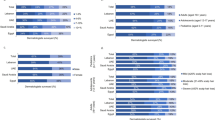Abstract
Alopecia areata (AA) is an autoimmune condition characterized by patchy, nonscarring hair loss. Few studies of AA have adequately included participants from underrepresented groups when evaluating the burden of AA in the United States. We conducted a cross-sectional study of personal/demographic factors and AA using the ongoing All of Us (AoU) Research Program. AoU enrolls adults over 18 years either as direct volunteers or through participating Health Care Provider Organizations by prioritizing recruiting underrepresented groups. We linked data from surveys and electronic health records (EHRs) to estimate the prevalence of AA by race/ethnicity, physical disability, sexual orientation/gender identity (LGBTQIA +), income, and education. The latest AoU release (version 5) includes 329,038 participants. Average age was 51.8 years (standard deviation, SD 16.7), and 60.2% of participants were female. Of these, 251,597 (76.5%) had EHR data and 752 were diagnosed with AA (prevalence, 0.30%; 95% CI 0.28–0.32). We used multivariate logistic regression adjusted for age and other factors to estimate the odds ratio (OR) and 95% confidence intervals (CIs) for prevalence of AA. Compared to Whites, Blacks and Hispanics had higher odds of AA (OR, 1.72; 95% CI 1.39–2.11 and OR, 2.13; 95% CI 1.74–2.59, respectively). Lower odds of AA were observed in participants with less than a high school degree (OR, 0.80; 95% CI 0.59–1.08), household income ≤ $35,000 (OR, 0.67; 95% CI 0.54–0.83), and no health insurance (OR 0.35; 95% CI 0.20–0.56). In this diverse population of US adults, participants with skin of color had higher prevalence of AA. Lower prevalence of AA among individuals with lower education and income levels and those lacking health insurance may reflect limited access to dermatologic care and potentially higher levels of undiagnosed AA in these groups.
Similar content being viewed by others
References
Strazzulla LC, Wang EHC, Avila L, Lo Sicco K, Brinster N, Christiano AM et al (2018) Alopecia areata: disease characteristics, clinical evaluation, and new perspectives on pathogenesis. J Am Acad Dermatol 78:1–12
Güleç AT, Tanriverdi N, Dürü C, Saray Y, Akçali C (2004) The role of psychological factors in alopecia areata and the impact of the disease on the quality of life. Int J Dermatol 43:352–356
Lee H, Jung SJ, Patel AB, Thompson JM, Qureshi A, Cho E (2020) Racial characteristics of alopecia areata in the United States. J Am Acad Dermatol 83:1064–1070
Thompson JM, Park MK, Qureshi AA, Cho E (2018) Race and alopecia areata amongst US Women. J Investig Dermatol Symp Proc 19:S47–S50
Gonzalez T, Fleischer AB Jr (2021) Reply to: “racial characteristics of alopecia areata in the United States.” J Am Acad Dermatol 84:e295–e296
National Institutes of Health (2021). All of Us Research Program—Protocol v1.19. U.S. Department of Health & Human Services
Safavi K (1992) Prevalence of alopecia areata in the first national health and nutrition examination survey. Arch Dermatol 1992(128):702
Hamed FN, Åstrand A, Bertolini M, Rossi A, Maleki-Dizaji A, Messenger AG et al (2019) Alopecia areata patients show deficiency of FOXP3+CD39+ T regulatory cells and clonotypic restriction of Treg TCRβ-chain, which highlights the immunopathological aspect of the disease. PLoS One 14:e0210308
Furue M, Yamazaki S, Jimbow K, Tsuchida T, Amagai M, Tanaka T et al (2011) Prevalence of dermatological disorders in Japan: a nationwide, cross-sectional, seasonal, multicenter, hospital-based study. J Dermatol 38:310–320
Benigno M, Anastassopoulos KP, Mostaghimi A, Udall M, Daniel SR, Cappelleri JC et al (2020) A large cross-sectional survey study of the prevalence of alopecia areata in the United States. Clin Cosmet Investig Dermatol 13:259–266
Fernández M, Alarcón GS, Calvo-alén J, Andrade R, McGwin G Jr, Vilá LM et al (2007) A multiethnic, multicenter cohort of patients with systemic lupus erythematosus (SLE) as a model for the study of ethnic disparities in SLE. Arthritis Care Res 57:576–584
Weckerle CE, Franek BS, Kelly JA, Kumabe M, Mikolaitis RA, Green SL et al (2011) Network analysis of associations between serum interferon-α activity, autoantibodies, and clinical features in systemic lupus erythematosus. Arthritis Rheum 63:1044–1053
Mirzoyev SA, Schrum AG, Davis MDP, Torgerson RR (2014) Lifetime incidence risk of alopecia areata estimated at 21% by Rochester epidemiology project, 1990–2009. J Invest Dermatol 134:1141–1142
Safavi KH, Muller SA, Suman VJ, Moshell AN, Melton LJ 3rd (1995) Incidence of alopecia areata in Olmsted County, Minnesota, 1975 through 1989. Mayo Clin Proc 70:628–633
Farhangian ME, McMichael AJ, Huang KE, Feldman SR (2015) Treatment of alopecia areata in the United States: a retrospective cross-sectional study. J Drugs Dermatol 14:1012–1014
Lundin M, Chawa S, Sachdev A, Bhanusali D, Seiffert-Sinha K, Sinha AA (2014) Gender differences in alopecia areata. J Drugs Dermatol 13:409–413
Uzuncakmak TK, Engin B, Serdaroglu S, Tuzun Y (2021) Demographic and clinical features of 1641 patients with alopecia areata, alopecia totalis, and alopecia universalis: a single-center retrospective study. Skin Appendage Disord 7:8–12
Villasante Fricke AC, Miteva M (2015) Epidemiology and burden of alopecia areata: a systematic review. Clin Cosmet Investig Dermatol 8:397–403
Tripathi R, Knusel KD, Ezaldein HH, Scott JF, Bordeaux JS (2018) Association of demographic and socioeconomic characteristics with differences in use of outpatient dermatology services in the United States. JAMA Dermatol 154:1286–1291
Author information
Authors and Affiliations
Contributions
IHM performed the data analysis. IHM, EAG, and MMT wrote the main manuscript text and prepared the tables. All authors edited and reviewed the manuscript.
Corresponding author
Ethics declarations
Conflict of interest
None declared.
Patient consent
Not applicable.
IRB approval status
Not applicable.
Additional information
Publisher's Note
Springer Nature remains neutral with regard to jurisdictional claims in published maps and institutional affiliations.
Rights and permissions
Springer Nature or its licensor (e.g. a society or other partner) holds exclusive rights to this article under a publishing agreement with the author(s) or other rightsholder(s); author self-archiving of the accepted manuscript version of this article is solely governed by the terms of such publishing agreement and applicable law.
About this article
Cite this article
Moseley, I.H., George, E.A., Tran, M.M. et al. Alopecia areata in underrepresented groups: preliminary analysis of the all of us research program. Arch Dermatol Res 315, 1631–1637 (2023). https://doi.org/10.1007/s00403-023-02548-y
Received:
Revised:
Accepted:
Published:
Issue Date:
DOI: https://doi.org/10.1007/s00403-023-02548-y




